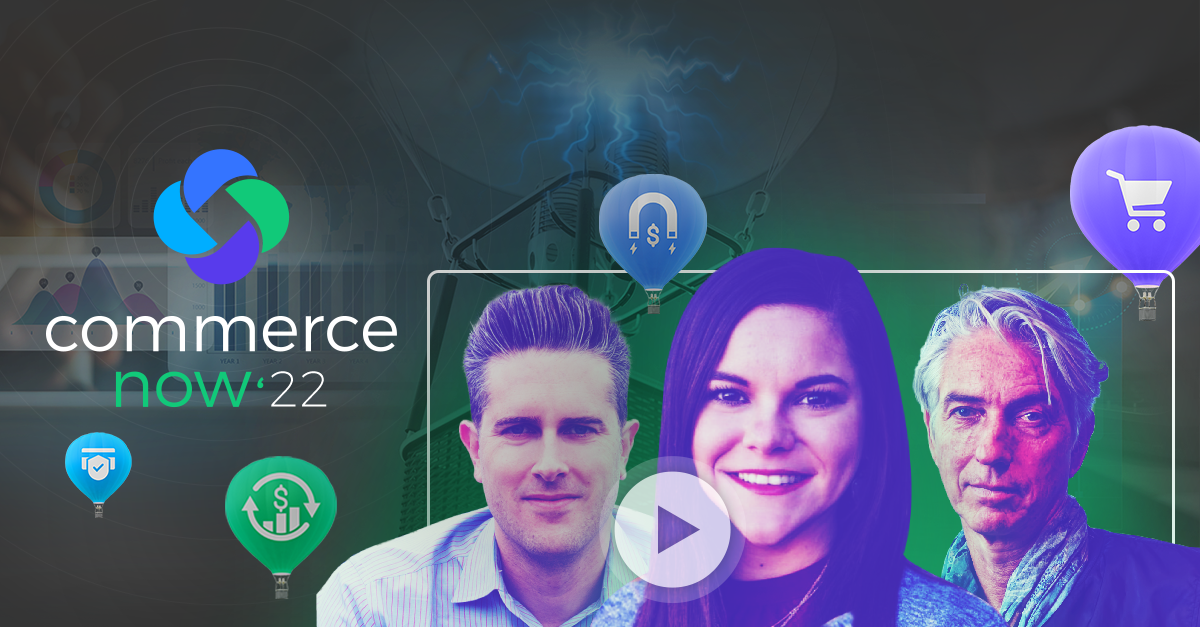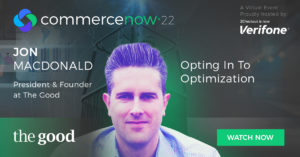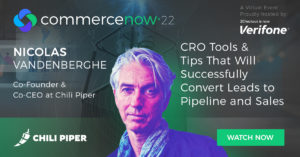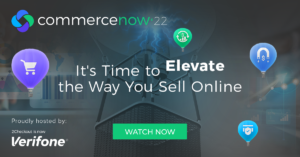Each summer during June, we host our CommerceNow online event, where a hand-selected group of eCommerce industry experts, including founders, CEOs, marketers, sales reps, and revenue leaders share their knowledge and expertise with a virtual audience.
This past June marked our sixth CommerceNow conference, and as in past years there was no shortage of inspiring sessions providing participants with new growth strategies and actionable guidance.
This is the second of a series of blog posts where we’ll share the key takeaways from several of the CommerceNow ’22 sessions. You can also register to watch all recorded webcasts here.
When it comes to eCommerce success, optimization is top of mind, and several of our sessions drilled down to the essentials for success in this realm.
Jon MacDonald, president and founder of The Good, contributed to the conversation with his session “Opting In To Optimization.”
“True CRO can deliver amazing results,” Jon emphasized. “Real CRO is a data-backed system for increasing the percentage of website visitors that convert into customers, or, more generally, take any desired action on your website.”
Jon said there are four basic laws of conversion rate optimization.
Law #1, said Jon, is that “best practices are for beginners,” because they are based on a trajectory of prescribing, then diagnosing, then reaching “meh” results. The more effective route is to diagnose and then prescribe, which leads to improved results.
“It’s not a one-and-done guessing game,” Jon pointed out. “It’s a scientific process based on iteration.”
Law #2 is that the scientific method, not silver bullets, is the system you use to make sense of your data in order to continually improve. Jon points out three misconceptions:
- There is a single good conversion rate or benchmark
- A website redesign will solve conversion problems
- Bigger tests are better tests
Instead, effective CRO relies on three different pillars, Jon shared: contextual baselines, exploratory testing, and continuous improvement.
Law #3 is that you can’t understand the new-to-file customer experience—you’re too close to your brand. “You can’t read the label inside the jar,” said Jon, meaning you need to really understand what the consumer, not the brand or vendor, is focused on.
Some symptoms of being stuck in a brand-focused approach, Jon shared, might be category dropdowns on your website with warehouse-like organization; brand-focused navigations; product descriptions that focus on manufacturing details; or site paths built around the understanding of the retailer, not the consumer.
To move from awareness of these roadblocks to action and improvement, he said, find ways to “listen to your customers in quantitative ways,” like:
- Analytics
- A/B testing
- Website chat logs
- Large scale user surveys
Law #4 is that CX drives conversions, not the other way around. Provide directional guidance, Jon emphasized, that makes it easy for consumers to find the product they want. He shared three W’s to focus on:
WHO is coming to your site? Use customer interviews to narrow down who you serve; surveys to identify customer types; and feedback from customer service team to expand demographics.
WHY are they there? Are they just researching a product or purchasing a product? Jon outlines the best ways to support both paths and identify the inefficiencies in your websites that prevent that final sale.
WHAT is getting in their way? Establish a journey map so you can walk in your customer’s shoes and see the bottlenecks and roadblocks that keep them from converting.
Ultimately, Jon emphasized, “Real CRO is not random—it uses qualitative and quantitative data. The good news is that success with CRO can lead to amazing year-over-year results, mobile revenue growth, and increase in return visitor conversions.”
To get all the inside scoop on how eCommerce leaders capitalize on unprecedented market demand and build thriving businesses, make sure to watch Jon’s full session here.
__________________________________
Kelsey George, account manager at Lucky Orange, added to the optimization conversation with her session “3 Ways to Get More Out of Your Website Analytics.”
Kelsey presented the cold, hard facts: 97% of visitors to your website will not convert. But just working to drive more and more traffic to your website doesn’t necessarily make a difference.
“Start with improving your website,” she advised. “Eighty percent of visitors are willing to convert for an excellent user experience.”
Some solutions that should be effective—but may not be—include spotting conversion hurdles with Google Analytics, which involves extensive, time-consuming monitoring; using focus groups for evaluation, which can be expensive and whose results can be subjective and biased; and offering a contact form, which requires the visitor to leave your site to get an answer.
Instead, Kelsey suggests focusing on three goals for analyzing your website:
- What are people doing on your site (and what is preventing them from converting)?
There’s nothing wrong with traditional analytics, Kelsey said, but they don’t always give you the full picture. Looking at visitor behavior tools illuminates their perspective as they visit your site. “Where did they click, what issues and pain points did they face while they were there?” Heat map tools, for example, can reveal visitor behavior, like where they are spending the bulk of their time on your site.
- What do visitors want? You need to engage with your customers and learn more about their wants, needs, and desires. You can use surveys, live chat, and announcements to get answers to these questions. Questions to ask:
- UX issues: What prevented you from checking out today? and What was the purpose of your visit?
- Visitor intent: How can we improve your experience? and Are you finding what you need today?
- Building brand equity: Is this the first time you’ve shopped with us? and Which products are you most interested in?
Live chat in real time can be extremely valuable, Kelsey pointed out. It keeps your visitors on your website while you provide them with answers so they can proceed with their purchase, or if they are struggling at some point doing their checkout. An announcement tool can also be very effective; when you see trends, you can use them to get attention at the right times.
- Which paid campaigns work best? “Clicks are really vanity metrics, unless they lead to conversions,” Kelsey pointed out. UTM parameters can be used for better data and easier tracking and can refine your data to narrow down what campaigns are really working.
“Website analytics are great for improving your customers’ experience,” Kelsey said.
“Everyone is capable of analyzing their website and making changes that impact their conversion rates.”
Watch Kelsey’s full session here, to get the full picture on how website analytics can help you improve conversion rates.
_____________________________________
“CRO Tools and Tips That Will Successfully Convert Leads to Pipeline and Sales” was presented by Nicolas Vandenberghe, co-founder and co-CEO of Chili Piper.
“The old way of inbound was the ‘capture the email’ imperative,” Nicolas opened. Marketing was traditionally focused on getting prospects’ email addresses, then passing that information on to sales. “This no longer works,” Nicolas pointed out.
In 2022, Nicolas explained, marketing emails are either ignored or go to your visitors’ spam folder, part of a trend toward the “dark funnel,” which is when customers are asking their friends, professional sources, or seeking information online—but not on your website (the funnel is “dark” from the vendor’s perspective, in other words). By the time they’ve reached their website they’ve likely already made up their minds.
“The new way of inbound is the ‘straight to meeting’ imperative—booking meetings with high- intent leads is paramount,” Nicolas explained.
Nicolas shared three tips for making this happen:
Tip #1: Shorten the forms your visitors need to fill out. You don’t need to collect all kinds of qualifying information that can be easily confirmed, but which can lead a visitor to get frustrated and abandon the form.
Tip #2: Add booking to your forms instead of just a message of “thank you, we will be in touch.” Only around 40% of sales will result from this approach, while visitors are nine times more likely to convert if they get a response within five minutes, Nicolas said.
Automation can take a visitor or lead from request directly to a calendar where they can schedule a meeting with the right person. The user experience is vastly improved and there’s a huge lift in conversion, Nicolas emphasizes.
Tip #3: Focus on your supporting text on your landing page.
- Add bullet points with real statistics from customers above the fold with no scrolling required
- Make your offer clear and compelling
- Set the expectation of what they’ll get (or not get, as in “no credit card required”)
- Provide social proof in the form of logos or quotes from similar buyers
Nicolas’s session included compelling, real-world examples of how this has worked, including his own company’s landing page. After applying these tactics, they made minor changes that resulted in a 55% increase in conversions.
If you want to discover additional conversion rate optimization best practices and the tools that will successfully help your business convert leads, watch Nicolas’ full session here.
To access and benefit from more expert tips and tricks from this year’s CommerceNow, view all this year’s sessions here.









